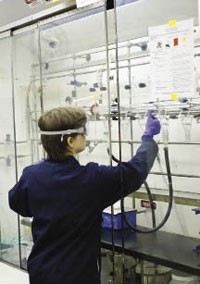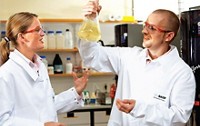Advertisement
Grab your lab coat. Let's get started
Welcome!
Welcome!
Create an account below to get 6 C&EN articles per month, receive newsletters and more - all free.
It seems this is your first time logging in online. Please enter the following information to continue.
As an ACS member you automatically get access to this site. All we need is few more details to create your reading experience.
Not you? Sign in with a different account.
Not you? Sign in with a different account.
ERROR 1
ERROR 1
ERROR 2
ERROR 2
ERROR 2
ERROR 2
ERROR 2
Password and Confirm password must match.
If you have an ACS member number, please enter it here so we can link this account to your membership. (optional)
ERROR 2
ACS values your privacy. By submitting your information, you are gaining access to C&EN and subscribing to our weekly newsletter. We use the information you provide to make your reading experience better, and we will never sell your data to third party members.
Business
Mission Support
Chemical firms plan a 17.0% boost in capital spending in 2006, but R&D spending predictions are up just 4.7%
by Marc S. Reisch
February 6, 2006
| A version of this story appeared in
Volume 84, Issue 6

Chemical companies will confront a number of difficulties in 2006, but that has not tempered their enthusiasm for investments in capital equipment to improve productivity or for investments in new product research.
It is likely that the U.S.-based companies that C&EN surveys annually will again have to cope with increased energy and raw material costs in 2006. And they'll continue to experience the unavoidable transformation of specialty chemicals into commodities. The companies may not always be able to push price increases through as they were able to do in 2005, but they can attempt to preserve and even enhance profits by spending on projects intended to increase their competitive posture.
Eighteen chemical makers that responded to this year's survey say they plan to boost capital budgets by a respectable 17.0% in 2006 compared with 2005, to a total of $8.7 billion. If the companies follow through on their plans, the increase will come close to the decade-high increase in 2005, when the group of 18 increased capital spending by 21.3%, compared with the year earlier.
A similar group of chemical firms also plans to enhance its investment in research, but it is making the increase at a more measured pace. The 18 firms budgeted a combined $3.9 billion for research in 2006, a 4.7% increase over 2005. Their spending plans closely parallel the 4.8% increase of last year. This year's increase should, like last year's, cover a little more than the 2% projected rate of inflation for R&D.
The overall forecast for future-oriented spending is sunny. The combined 2006 budget of the 14 firms that supplied both R&D and capital spending data is $10.9 billion. The rapid run-up in spending marks a decade high. Only two years ago, in 2004, the group's future-oriented spending hit a decade low of $8.5 billion. Capital spending increases have, for the most part, accounted for the rapid change. The last time this group spent nearly so much on its future was in 1998, when it spent $10.7 billion.
Account for inflation, however, and the funds earmarked for future-oriented projects don't go as far as they did 10 years ago. The $10.9 billion the group plans to spend this year is only $9.1 billion in 1996 dollars.
Because of the recent boost in capital spending, the ratio of investment in new equipment to investment in research is on the rise. At the decade low in 2004, only 60% of future-oriented funds were slated for capital improvements. Budgets for 2006 direct 66% of funds to capital improvements, but that is still not as high as the 70% of funds spent on new equipment in 1998.
Funds directed toward R&D tend to fluctuate in a narrower range than do those for capital improvements. So when capital spending rises dramatically, a proportionately smaller share of budgets goes to fund research. This year, the firms in C&EN's survey expect to spend 34% of future-oriented funds on research, compared with 40% of such funds at the decade high in 2004.
C&EN conducts its survey in January of each year just as companies are getting ready to announce the previous year's financial results. Often, companies aren't quite ready to reveal future-oriented spending budgets to the investment community, and so the composition of firms participating in the survey can change. Last year, for instance, Engelhard was able to forecast capital expenditures and appeared on the table in last year's survey (C&EN, Feb. 7, 2005, page 18). But this year, the firm was only able to supply a research budget for 2006. As a result, the firm appears only in this year's research spending table.
Mergers and acquisitions can also affect the composition of the tables. Last year, Crompton and Great Lakes Chemical appeared in both the capital spending and R&D tables. The two merged in July 2005, and only the surviving firm, Chemtura, appears in both tables.
In addition, priorities and spending plans may change over the course of the year. For instance, companies surveyed in January 2005 expected to increase capital spending by 12.6% in 2005. However, firms that participated in this year's survey say they increased 2005 capital outlays by 21.3%. So the survey can only forecast spending plans at a moment in time.
For R&D, it's a similar story. Last year's group expected to increase R&D by 2.3% in 2005. This year's group reports that it actually increased spending by 4.8%.
Of the 18 companies surveyed for their 2006 capital spending plans, 15 aim to increase spending on new plants and equipment. Two plan to spend the same in 2006 as they spent the year before, and only one firm plans to cut back. This compares with 16 that increased spending in 2005 and two that cut spending.
Many firms intend to make capital improvements to enhance efficiency and productivity. Lyondell Chemical, for instance, points out that it will spend most of its budget on "minor plant efficiency projects" and on "profit enhancement" within the Equistar ethylene, propylene, and polypropylene business, "including projects devoted to further coproduct upgrading and raw material flexibility." The firm plans a 53.0% boost in capital spending to $404 million.
Like Lyondell, Eastman Chemical will direct capital funds to efficiency projects. But in Eastman's case, efficiency comes in the form of a new plant under construction in Columbia, S.C., that uses the firm's IntegRex technology to efficiently convert p-xylene to polyethylene terephthalate. Eastman plans to increase capital spending 31.2% to $450 million.
Other firms plan incremental increases in capacity to make more efficient use of existing facilities. Albemarle plans to increase its 2006 capital expenditures by 42.9% to $100 million, in part to expand its refinery catalysts plant in Bayport, Texas.
C&EN predicts that the group's capital spending as a percentage of sales will be 4.9%, up from 4.6% in 2005. The estimate assumes an 8.0% increase in sales in 2006. The group achieved a 10-year high in 1998 when spending on capital projects reached 9.6% of sales. The decade low was in 2004 when the group spent 4.5% of sales.
Of the 18 firms surveyed on R&D spending plans, 13 plan to increase spending in 2006, and the others plan to keep spending at the same level as in 2005. This compares with 14 that increased expenditures in 2005, two that made no change, and two that cut their budgets.
C&EN estimates that, in 2006, R&D as a percent of sales for the group will hit a decade low of 2.8%. The decade high was 4.3% in 1999. Last year, the group spent 2.9% of sales on R&D.
Inflation chips away at the buying power of dollars devoted to research. For 17 firms that have a 10-year history of R&D expenditures, actual dollars directed toward the development of new products and processes will be $3.8 billion in 2006. Those funds represent only $3.2 billion on a constant-1996-dollar basis. The inflation-adjusted decade high was $3.6 billion in 2000.
In its annual survey of member-company spending plans, the American Chemistry Council (ACC) says firms will spend more lavishly on capital projects in 2006 than they did in 2005. It attributes the general rise in reinvestment to the recent improvement in industry profitability. However, the survey, conducted in the fall of 2005, suggests that respondents at the time were only planning a 10% increase in spending-much less than the 17% rise for the group C&EN surveyed.
The ACC survey also finds that chemical firms plan to spend 29% of their budgets on capacity expansion for existing products, up from 22% in 2005. The share of the budget devoted to capacity for new products will slip from 10% to 6%. More of the budget, 33%, will go to replace worn-out plants and equipment, instead of the 29% devoted to that task in 2005. Efforts to improve operating efficiency will claim 14% of the budget, up from 10% last year.
ACC also predicts that spending on environmental protection and health and safety will slip slightly as a share of the total capital budget. And it adds that firms will spend the same share of the budget on projects specifically geared to energy savings as in the year before.
In addition, ACC finds that chemical firms are unlikely to splurge on R&D in 2006. The industry group predicts an average 3% increase in R&D budgets for chemical firms in 2006 compared with the 4.7% rise that respondents to C&EN's survey predict. But ACC is quick to underscore the importance of company investments in R&D. According to its survey, nearly 14% of basic and specialty chemical company revenues are from products and services developed within the past five years.
However, a recently released broader survey of U.S.-based companies, conducted in the summer of 2005, finds that many firms intend to invest more in new business projects and expect to expand growth opportunities through research and external collaboration. The "Industrial Research Institute's R&D Trends Forecast for 2006" notes "a general shift to higher spending on R&D, with even more emphasis on new business and less on supporting existing business."
Almost half of the more than 100 respondents, representing a broad array of industrial businesses that sponsor research, expect to increase R&D expenditures by more than 2.5%, whereas 22% expect to hold spending at the same level as in 2005 or reduce it. According to the report's author, Alan D. Ayers, manager of external technology at Energizer Battery Manufacturing, the survey finds "a shift downward in support of existing business and increases in new business projects to achieve the needed growth to survive and thrive."
But in a study released last October on innovation by the world's top 1,000 corporate R&D spenders, consulting firm Booz Allen Hamilton cautions that "there is no direct relationship between R&D spending and significant measures of corporate success such as growth, profitability, and shareholder return."
On the other hand, the study points out that companies that spend much less on R&D as a percentage of sales than competitors are less profitable. And more important, Booz Allen adds, "successful innovation demands careful coordination and orchestration both internally and externally. How you spend is far more important than how much you spend."
Yakov Kutsovsky, global R&D director at Cabot Corp., agrees. Kutsovsky says his company spends about one-third of its R&D budget on incremental product and process improvement efforts and approximately two-thirds of the budget on new business opportunities. But those markers are not set in stone.
Cabot uses the stage-gate process to manage the incremental improvement projects. The stage-gate process advances or kills research projects based on whether they meet certain milestones. But Kutsovsky points out that new business opportunities need to be coddled, and the firm helps them through "business boards." These boards, which include senior managers, marketing personnel, R&D, and safety and health supervisors, determine what a new business venture needs to succeed.
"We don't make a fixed allocation to the business boards," Kutsovsky says. Instead, Cabot funds opportunities that make sense and allow the firm to bring valuable new products to market. In many cases, the firm finds new business opportunities by leveraging the technology it already has. But when it comes to generating new ideas, money alone isn't the answer and "there is no one recipe for success," he says.
Table 1: Capital Investments
Double-digit capital spending increases are set for a second year for a group of 18 U.S. firms
Table 2: Research Spending
As a group, 18 U.S. chemical firms plan to increase research spending in 2006 at about 5%, the same rate as last year







Join the conversation
Contact the reporter
Submit a Letter to the Editor for publication
Engage with us on Twitter